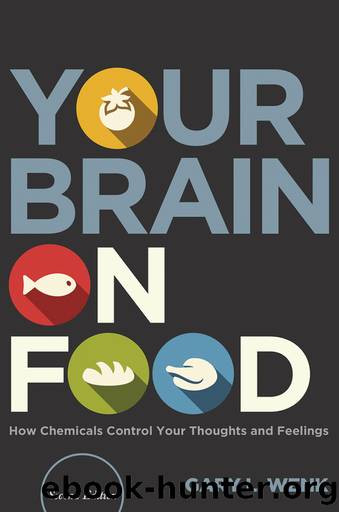Your Brain on Food by Professor Gary L. Wenk

Author:Professor Gary L. Wenk
Language: eng
Format: epub
Publisher: Oxford University Press
Published: 2014-04-15T00:00:00+00:00
COCAINE
The comedian Robin Williams once quipped that cocaine is Godâs way of telling you that youâre making too much money. The United States must indeed be a wealthy country, considering that 3 million of our fellow citizens abuse this drug; this is six times the number of heroin addicts in our nation. It is estimated that 50% of Americans between the ages of 25 and 30 years have tried cocaine.
What does cocaine do in the brain? First, it binds to sodium ion channels and blocks them from functioning. This action stops the flow of action potentials and prevents neurons from communicating with each other. Cocaine also blocks the conduction of pain signals, which explains why, after it was isolated from the coca plant (Erythroxylon coca) in 1855, it was used as a local anesthetic, including for the eye and for toothaches. But ultimately, its anesthetic actions would be discovered to have nothing to do with the reason for its later illegal street use: its ability to produce euphoria.
Cocaine acts similarly to amphetamine with regard to its ability to enhance the effects of dopamine and serotonin at the synapse. The actions of cocaine on the brain lead to increased alertness, reduced hunger, increased physical and mental endurance, increased motor activity, and an intensification of most normal pleasures. This last feature may explain why so many claim that cocaine enhances emotional and sexual feelings. Cocaine abusers usually co-administer other drugs that are brain depressants (e.g., alcohol, heroin, or marijuana) to decrease the unpleasant hyperstimulant aspects of cocaine.
Approximately 16 to 32 milligrams of cocaine is an effective street dosage that is usually without immediate negative side effects. An increase in heart rate usually occurs within about 8 minutes after administration and dissipates 30 to 40 minutes later. The half-life, or the time it takes for half of the drug to exit the blood and body, is about 40 to 50 minutes. Cocaine will actually degrade spontaneously in the body to produce an inactive compound with a tongue-twister name, benzoylecgonine. The physiological effects of cocaine are therefore much shorter than those of amphetamine. Partly for this reason, most users claim that it does not âwear outâ the body in the same way that amphetamine does.
Getting cocaine to its site of action within the brain first requires getting adequate amounts of the drug into the blood. Snuffing cocaine by applying it to mucous membranes inside the nose is much more effective than either oral administration or intravenous use, because the drug enters the blood and brain more quickly and is therefore more immediately euphorigenic. Unfortunately, there is a problem with this approach to getting cocaine into the blood. Cocaine constricts the blood vessels feeding the cartilage in the bridge of the nose and, with repeated nasal application, leads to the ischemic (lack of blood) death of the tissues supporting the end of the nose. Initially, the irritation to the tissue causes a runny nose; ultimately, the irritation leads to a true necrosis, or cell death, and the end of the nose either collapses or becomes quite distorted.
Download
This site does not store any files on its server. We only index and link to content provided by other sites. Please contact the content providers to delete copyright contents if any and email us, we'll remove relevant links or contents immediately.
The DNA Book by DK(746)
The Spike by Mark Humphries;(719)
The End of Food Allergy by Kari Nadeau MD PhD & Sloan Barnett(661)
Extra Life by Steven Johnson(633)
Your Brain Is Always Listening by Dr. Daniel G. Amen(617)
Unlocking Eden: Revolutionize Your Health, Maximize Your Immunity, Restore Your Vitality by Belt Daniel & Horn Joe(568)
The Hospital by Brian Alexander(566)
How to Sleep by Rafael Pelayo(560)
The Low-FODMAP IBS Solution Plan and Cookbook by Rachel Pauls(545)
The Covid Survival Guide: What the Virus Is, How to Avoid It, How to Survive It by Rowell David(543)
The Big Book of Baby Names by Marissa Charles(527)
The Hashimoto's AIP Cookbook: Easy Recipes for Thyroid Healing on the Paleo Autoimmune Protocol by Emily Kyle MS RDN CLT HCP & Phil Kyle Chef(515)
Linda Goodman's Love Signs by Linda Goodman(497)
Better Living Through Neurochemistry - A guide to the optimization of serotonin, dopamine and the neurotransmitters that color your world by James Lee(494)
Lymph & Longevity by Gerald Lemole(493)
The Miracle Pill by Peter Walker(486)
Thrivers by Michele Borba Ed. D(484)
Stroke For Dummies by John R. Marler(474)
Immunity by Jenna Macciochi(464)
